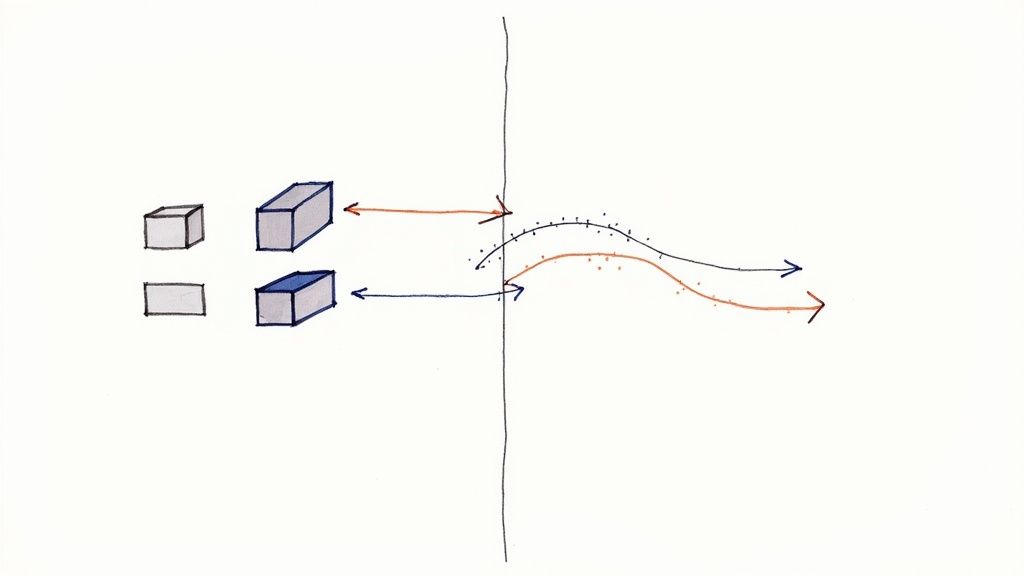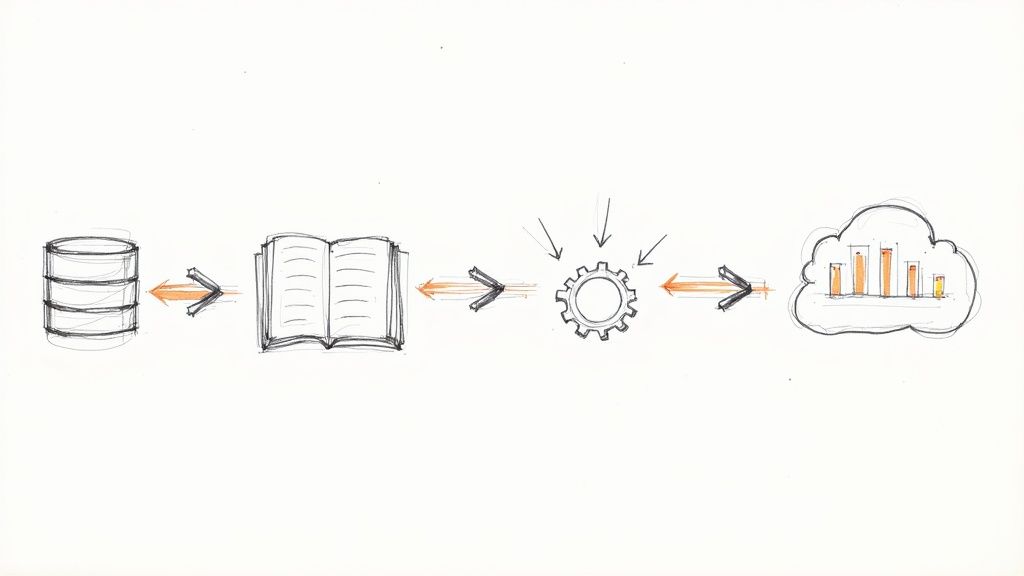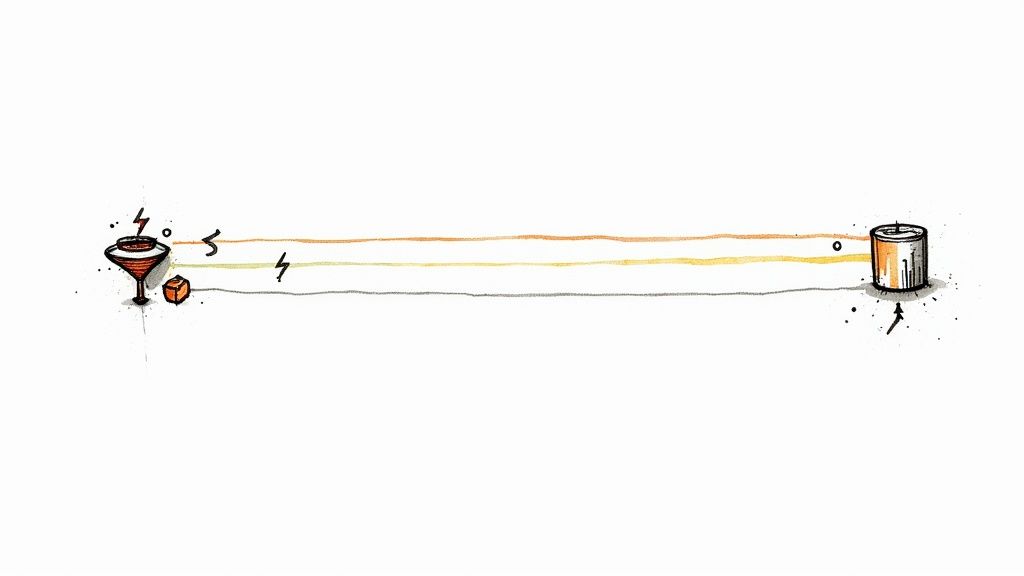Neo4j Real-Time Analytics for Instant Insights
Discover how to leverage Neo4j real-time capabilities for instant analytics, fraud detection, and recommendations. Your guide to dynamic graph data.
When your business needs answers from its data, waiting around simply isn't an option. Neo4j real-time processing is all about getting those insights instantly, analyzing complex connections the moment they happen. This is a huge leap from the old way of doing things with slow, periodic batch updates. Now, applications can react to events in milliseconds, powering things like immediate fraud detection, live recommendations, and dynamic supply chain adjustments on the fly.
Why Real-Time Graph Analytics Is a Game Changer
Think about trying to understand a fast-paced basketball game by only looking at a few snapshots taken every ten minutes. Sure, you'd see the players on the court, but you'd miss all the action—the critical passes, the clutch defensive plays, and the split-second decisions that actually win the game. That’s what traditional data analysis often feels like; it gives you delayed pictures of a reality that has already moved on.
Now, imagine you had a live video feed of that same game. That’s what Neo4j real-time processing feels like. It doesn’t just show you where the players are; it captures every interaction, every connection, and every event as it happens. This ability to see the complete, unfolding context is precisely what sets real-time graph analytics apart.
The Inherent Speed of Graphs
Let's be honest: traditional relational databases were never built for this kind of speed. To figure out how data is connected, they have to perform complex and computationally expensive JOIN operations, painstakingly piecing together data from different tables. As your data grows and the connections multiply, these queries slow down exponentially. It’s a bottleneck that makes genuine real-time insights practically impossible.
Graph databases like Neo4j are built on a completely different philosophy. Relationships aren't something you calculate on the fly; they're stored as first-class citizens, right there with the data itself. This core concept is called index-free adjacency, and it means that moving from one node to another is as simple as following a direct pointer.
Instead of grinding through massive tables to find matching keys, Neo4j just follows a direct path from one piece of data to the next. This architectural design completely sidesteps the performance penalty of complex relationship queries, making it a natural fit for high-speed, real-time work.
Solving Data Latency Challenges
This structural advantage is the key to cracking the data latency problems that hamstring so many modern applications. Take fraud detection, for instance. A system has to analyze a transaction’s entire network of connections—previous purchases, associated devices, account history—all in a matter of milliseconds. A relational database would choke trying to execute that query. A graph database handles it without breaking a sweat.
This raw speed unlocks a new generation of truly responsive and intelligent applications. Suddenly, you can:
- Prevent fraud: Spot and block a sketchy transaction before the money is gone.
- Personalize experiences: Update product recommendations the instant a user clicks on something new.
- Optimize logistics: Reroute a delivery truck in real-time because of a sudden traffic jam.
By delivering immediate, context-rich insights, Neo4j gives developers the foundation to build applications that operate at the true speed of business.
Architecting Your Real-Time Data Ecosystem
Building a system that operates in the now takes more than just a fast database. It demands a solid architectural blueprint. To get true Neo4j real-time performance, you need to design an ecosystem where data flows instantly and intelligently. This means ditching the old model of periodic, scheduled updates and embracing something far more dynamic.
The key is to adopt an event-driven architecture. Think of it as a central nervous system for your business. Instead of a brain constantly polling every part of the body for updates, each part sends an immediate signal—an "event"—the moment something happens. A sale is made, a user clicks a button, a sensor reading changes; each action becomes an event broadcast across the system.
This approach ensures that every component, including your Neo4j graph, can react instantly to new information. The system is no longer waiting for a batch job to run overnight. It's alive, processing a continuous stream of events that mirror what's happening in your business right now.
The Role of Message Queues and Kafka
In this nervous system analogy, message queues are the synapses—the critical junctions that transmit signals. Tools like Apache Kafka are indispensable for managing this constant flow of event data. Kafka acts as a durable, high-throughput pipeline sitting between your data sources (like your applications) and consumers (like Neo4j).
When an application generates an event, it publishes it to a Kafka topic. Other services, including a connector for Neo4j, subscribe to these topics and consume the events as they arrive. This "publish-subscribe" model decouples your systems, creating a remarkably resilient and scalable data flow. For a deeper dive, you can explore guides on managed Kafka to see how this complex infrastructure can be simplified.
This infographic helps visualize how all these moving parts come together to deliver real-time value.
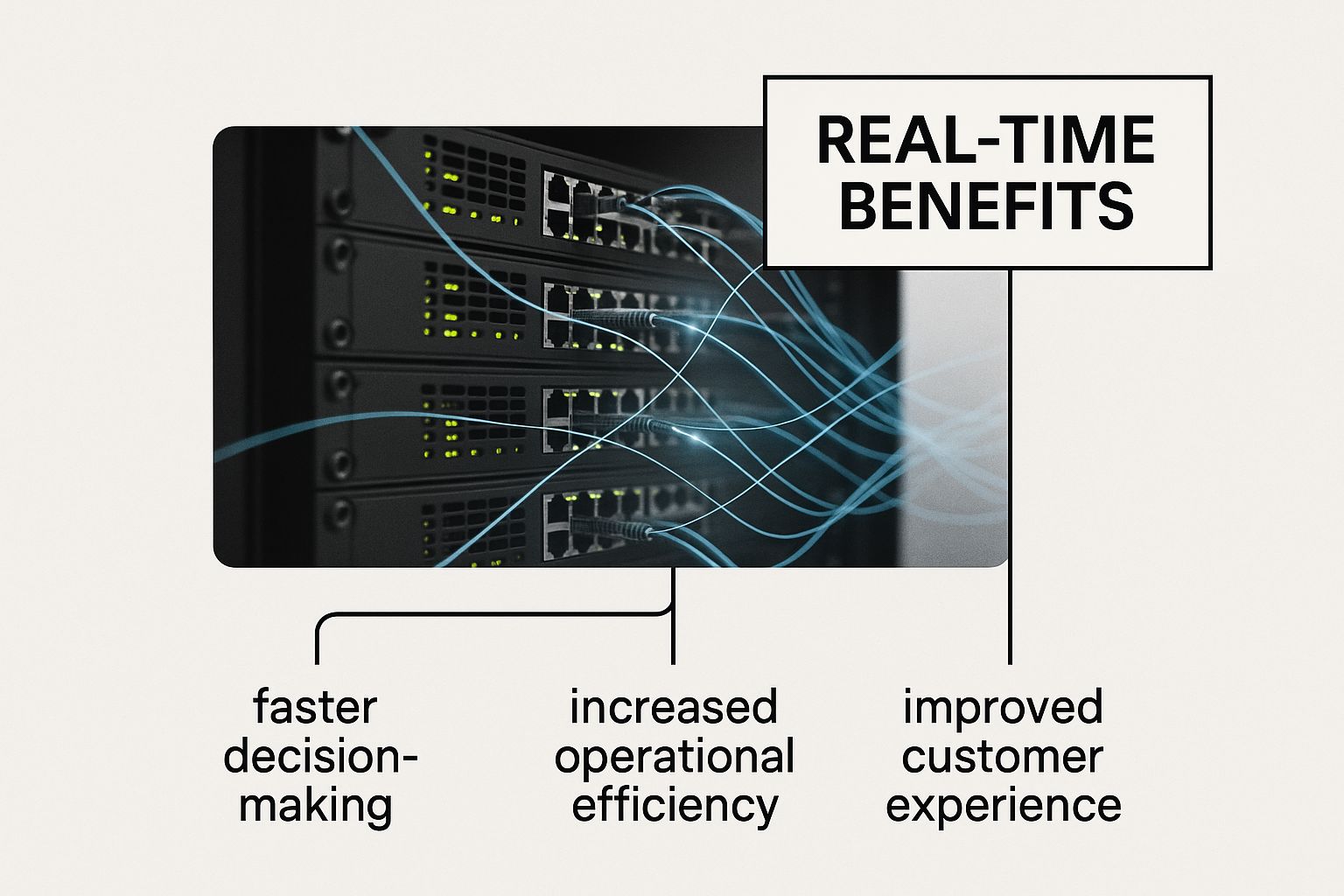
As you can see, a well-designed ecosystem isn't just about raw speed. It's about building a scalable data backbone that can power immediate insights across your entire organization.
Comparing Real-Time Architectural Patterns
Choosing the right architectural pattern is crucial for success. Each approach has its own strengths and weaknesses, making it suitable for different scenarios. Below is a table that breaks down some common patterns for building real-time pipelines with Neo4j.
PatternPrimary Use CaseProsConsDirect API CallsSimple, low-volume updates from a single application.Easy to implement; no extra infrastructure needed.Tightly couples services; not scalable; can overwhelm the database.Message Queue (e.g., Kafka)High-throughput, decoupled data ingestion from multiple sources.Highly scalable and resilient; decouples producers and consumers.Adds complexity and operational overhead.Change Data Capture (CDC)Syncing legacy or relational databases with Neo4j in real-time.Low-latency; minimal impact on source systems; captures every change.Requires specialized tools; can be complex to set up initially.Batch ProcessingNon-critical updates, data warehousing, and periodic reporting.Simple for large, bulk data loads; cost-effective for non-urgent tasks.High latency; data is never truly real-time; can strain resources.
Ultimately, many modern systems use a hybrid approach, often combining CDC with a message queue like Kafka to get the best of both worlds: low-impact data capture and scalable, decoupled streaming.
Unlocking Data with Change Data Capture
So, an event-driven architecture is perfect for new application data, but what about all the valuable information locked away in your existing databases? This is where Change Data Capture (CDC) comes in. CDC is a technique that monitors a source database's transaction logs for any changes—inserts, updates, or deletes.
Key Takeaway: Think of CDC as a stenographer for your database. It records every single change as it happens, without getting in the way or slowing down the source system. It captures the "what," "when," and "how" of every data modification.
Instead of running slow, resource-hungry queries against your production databases, CDC taps directly into this stream of changes. This gives you a granular, low-latency feed of every modification. When you pair this with Kafka, you create an incredibly powerful pipeline.
- Capture: A tool like Streamkap reads changes directly from a database log (e.g., PostgreSQL, MySQL).
- Stream: The change event is instantly published to a Kafka topic in a clean, structured format.
- Consume: A Neo4j connector subscribes to the topic, consumes the event, and updates the graph.
This process ensures your Neo4j graph is always an up-to-the-minute reflection of your operational reality. It’s the essential bridge between legacy systems and your modern, graph-powered applications, making sure your real-time analytics are always based on the freshest data possible.
Here’s a rewritten version of the section, crafted to sound like an experienced human expert.
Fine-Tuning Your System for High-Speed Workloads
Building a real-time system is one thing. Making sure it doesn't buckle under the constant pressure of high-speed, high-volume data is a completely different ballgame. For a Neo4j real-time application to truly deliver, you have to tune it for extreme performance. This isn't about just flipping a switch; it involves specific configurations and infrastructure choices that let the system handle a massive flood of queries without dropping the millisecond response times your users demand.
Think about it: when data is constantly streaming in and queries are hitting the database every second, performance isn't just a nice-to-have—it's everything. A tiny delay could be the difference between stopping a fraudulent transaction in its tracks or letting it slip through. It could mean serving a perfectly timed recommendation or losing a customer's attention forever. This is exactly why so much of Neo4j's engineering is obsessed with both raw query speed and the ability to scale read capacity when the heat is on.
Scaling Read Capacity for Non-Stop Analytics
As your data grows, the appetite for real-time analytics tends to explode right alongside it. To keep up, you need a graph platform that can scale its read capacity without a fuss. Just throwing more hardware at the problem isn't a long-term strategy; the architecture itself has to be built for elastic performance.
Recent breakthroughs in Neo4j's cloud infrastructure have tackled this problem head-on, pulling off a remarkable 15-fold increase in real-time data read capacity within each cluster. That's a huge leap. It means the platform can chew through 15 times more analytics work without breaking a sweat or slowing down. Businesses can now run incredibly data-heavy queries and support a rapidly growing user base without hitting a performance wall. You can get the full story on these platform updates and their performance impact.
This isn't just a small bump in speed. It fundamentally changes the scale at which a business can operate. You can now run uninterrupted, data-intensive analytics even as your customer data volumes go through the roof.
This kind of scalability is the secret sauce for things like live dashboards, real-time recommendation engines, and sophisticated fraud detection systems—all of which need to serve thousands of people at once with instant, accurate insights.
Locking It Down with Enterprise-Grade Security
In a real-time world, speed can never come at the cost of security. This is especially true when you're handling sensitive data in heavily regulated fields like finance and healthcare. A system that's truly ready for the enterprise has to weave robust security measures right into its core, making sure they work seamlessly without creating performance bottlenecks.
Neo4j’s answer is a multi-layered security approach built for the most demanding situations. Here are a few key features that make a difference:
- Top-Tier Compliance: With certifications like SOC 2 Type 2 and HIPAA, you can be confident the platform meets strict regulatory rules for handling private data.
- Customer-Managed Encryption Keys (CMEK): This puts you in the driver's seat. You can use your own encryption keys to lock down your data, giving you total control over who gets access based on your own security policies.
- Real-Time Security Log Forwarding: Every security-related event can be streamed instantly to your monitoring tools (like a SIEM). This gives you an immediate heads-up on potential threats and keeps a perfect audit trail.
These aren't just add-ons; they're baked right in. It’s what allows companies to deploy Neo4j real-time applications with the peace of mind that their data is protected by best-in-class security protocols.
A Real-World Gut Check from Intuit
The best way to see the power of an optimized and secure real-time graph is to look at it in action. Take Intuit, the global financial tech giant. They were facing a massive challenge: how to manage and secure a sprawling IT infrastructure with hundreds of thousands of endpoints. Finding and fixing security vulnerabilities across a network that big was a monumental task.
By bringing in Neo4j, Intuit built a living, breathing graph of their entire technology ecosystem. This graph connects every server, application, and dependency, creating a single, reliable source of truth for their security posture.
Now, when a new threat like the Log4j vulnerability emerges, Intuit’s security teams can run a single Cypher query. The result? In minutes—not days or weeks—they can identify every single affected system across their global operations. This ability to pinpoint and resolve critical vulnerabilities at lightning speed is a game-changer, perfectly illustrating what happens when you combine performance, scale, and security in a real-time graph database.
Getting Your Data into Neo4j in Real Time with CDC
Let's move from theory to practice. This is where the real magic of a Neo4j real-time system happens. To keep your graph in perfect sync with your operational databases, you need a data pipeline that’s fast, modern, and efficient. This is where Change Data Capture (CDC) leaves old-school batch ETL processes in the dust.
Think of batch jobs like developing film. You take a snapshot, go through a whole process, and eventually get a picture of a moment that’s already long gone. For any application that needs up-to-the-second data, that delay is a killer. CDC, on the other hand, is like a live video feed. It captures every single change from your source database the instant it occurs.
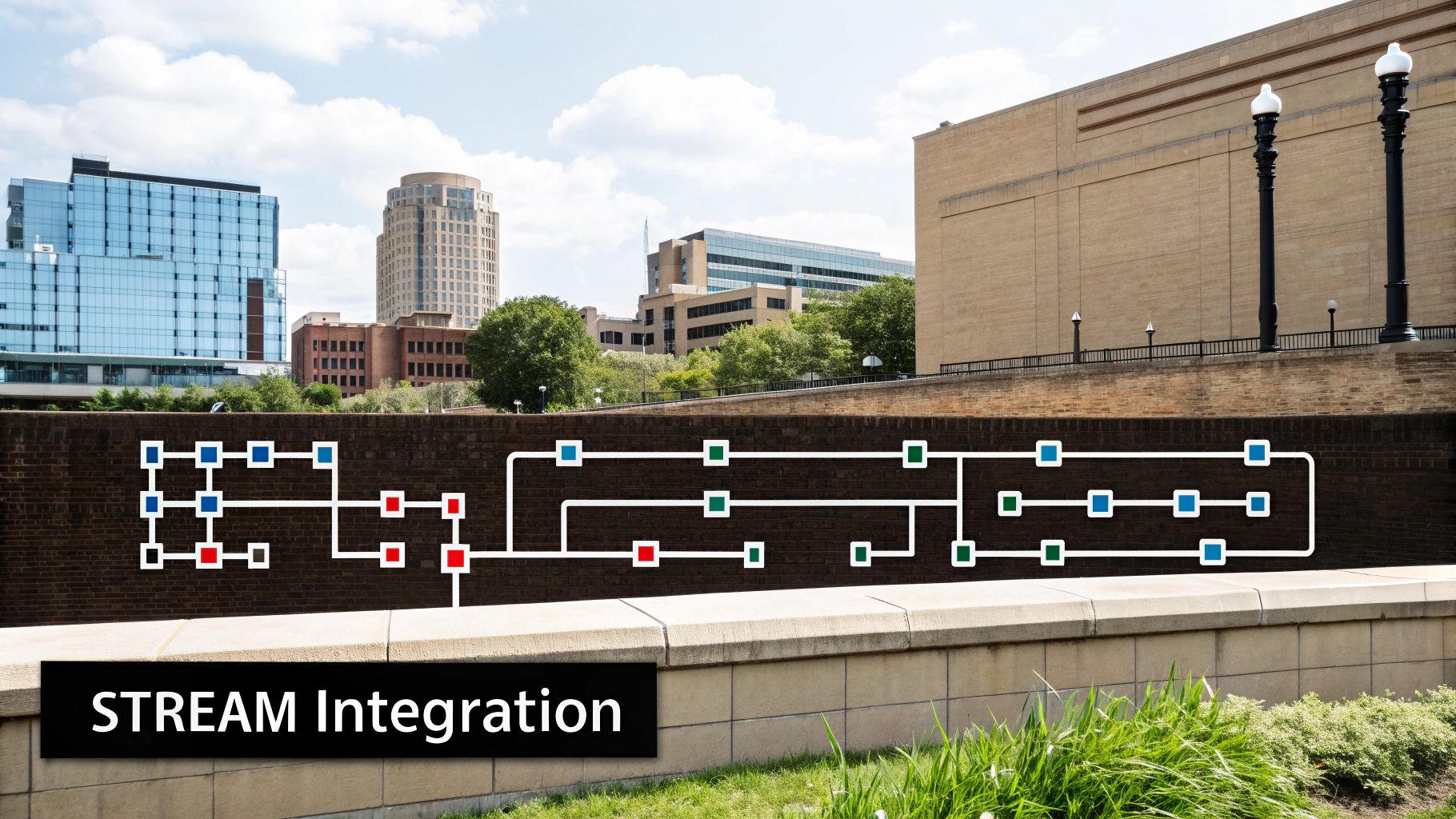
This approach is so much smarter than running heavy, periodic queries that hammer your production systems. Instead, CDC taps directly into the database's transaction logs. It’s a gentle, low-impact way to ensure your graph is an exact, millisecond-accurate mirror of reality.
The Modern CDC Pipeline
A solid CDC pipeline has a few key pieces that need to work together seamlessly. A modern platform like Streamkap handles all the complex plumbing for you, turning what could be a massive engineering headache into a straightforward, manageable workflow.
Here’s how it works, broken down into three stages:
- Capture: A connector hooks into your source database’s logs—like the Write-Ahead Log (WAL) in PostgreSQL—and reads every change event (inserts, updates, and deletes) as it happens.
- Stream: These events are immediately sent to a message broker, usually Apache Kafka, which organizes them into a reliable, ordered stream of changes.
- Consume: A sink connector listens to the Kafka stream, grabs the change events, and turns them into Cypher queries that update your Neo4j graph.
This setup creates a buffer between your source database and Neo4j. If one component has an issue, it doesn't take down the entire data flow, making the whole system much more resilient.
Setting Up Your Data Stream
Let’s walk through a real-world example. Say you have a PostgreSQL database managing users and their orders. Your goal is to get this data into a Neo4j graph, live.
Your first step is to set up a source connector in a platform like Streamkap. You’ll just need to provide your database credentials and point it to the tables you want to watch. The platform takes care of the tricky parts of reading the transaction log behind the scenes. You can get a deeper dive into how Change Data Capture for streaming ETL creates these kinds of live data pipelines.
The real beauty of a managed CDC platform is how it handles schema evolution. If a developer adds a new column to your users table in PostgreSQL, the platform automatically detects it and pushes the change through the pipeline. Your Neo4j model stays in sync without you lifting a finger.
Once connected, every INSERT into the orders table or UPDATE to a user's record is captured as a unique event and sent straight to a Kafka topic.
From Stream to Graph: Updating Neo4j
The final piece of the puzzle is getting that data into Neo4j. This is the job of the sink connector, which constantly reads from the Kafka topic. It parses each incoming event and constructs the right Cypher query to make the change in the graph.
For instance, a new order event arriving in the Kafka topic might look something like this:
{
"op": "c", // 'c' stands for create/insert
"after": {
"order_id": 101,
"user_id": 42,
"product": "Graph Database Pro",
"amount": 49.99
}
}
The sink connector would see this and immediately generate the right Cypher query to create a new Order node and link it to the correct User.
MATCH (u:User {id: 42})
MERGE (o:Order {id: 101})
ON CREATE SET o.product = 'Graph Database Pro', o.amount = 49.99
MERGE (u)-[:PLACED]->(o)
By automating this capture-stream-consume loop, you get a pipeline that just works, continuously keeping your Neo4j real-time graph up to date. This means your fraud detection, recommendation engines, and analytics are always running on the freshest, most accurate data you have.
Real-World Use Cases: Where Neo4j Shines
Architectural diagrams are great, but the real magic happens when Neo4j real-time capabilities start solving actual business problems. Seeing how it untangles complex connections on the fly is what really shows its value, powering applications that would have been pure science fiction just a few years ago.
Across industries, from finance to retail, the need for immediate, context-aware insights is no longer a "nice-to-have." These aren't just abstract ideas; these are high-impact solutions in production today, fundamentally changing how companies operate.
Financial Services and Fraud Detection
In finance, every millisecond counts. A tiny delay can be the difference between a secure transaction and a massive financial breach. This is where real-time graph analytics become a secret weapon for banks and financial institutions, helping them fight fraud as it unfolds, not after the damage is done.
Think about a simple credit card swipe. In that split second, a Neo4j system can:
- Instantly map the cardholder's recent transaction patterns.
- Scan for any links to known fraudulent accounts, devices, or even addresses.
- Analyze the geographic path of recent purchases.
By racing through this web of connections, the system can spot red flags—like a card being used in New York and then in London five minutes later—and decline the fraudulent transaction before any money is lost. It’s this proactive defense that saves the industry billions every year.
E-commerce and Hyper-Personalization
The biggest names in e-commerce know that a generic, slow recommendation engine is a direct path to lost revenue. With a neo4j real-time graph, recommendations aren't just static lists; they're living, breathing suggestions that adapt the very moment a customer interacts with the site.
When a shopper clicks on a product, their interest profile is updated instantly within the graph. The very next page they load can showcase recommendations based not only on that single click but on the connected tastes and behaviors of thousands of similar shoppers. This creates a seamless, genuinely personal shopping journey that keeps customers engaged and boosts sales.
This goes beyond just showing products. Real-time data can trigger entire automated processes. Understanding What is Workflow Automation? helps put this into perspective, as user behavior can kick off anything from a targeted marketing email to an automatic inventory adjustment in the warehouse.
Logistics and Supply Chain Optimization
Today's supply chains are a dizzying web of suppliers, warehouses, shipping lanes, and delivery routes. A single disruption—a sudden storm, a major traffic accident, or a component shortage—can send shockwaves through the entire network, causing costly delays.
Real-time graph databases give logistics managers a live, dynamic map of their entire operation. If a critical shipment gets stuck, they can run a query in seconds to find the best possible alternative route, instantly calculating all the downstream effects and dependencies. This kind of agility is crucial for minimizing disruptions, cutting costs, and making sure goods get where they need to go on time.
Grounding Generative AI with Factual Data
One of the most exciting new frontiers for Neo4j is grounding generative AI (GenAI) applications. Large language models (LLMs) are incredibly powerful, but they have a well-known tendency to "hallucinate" or confidently provide outdated information. A real-time knowledge graph serves as the source of truth—the factual memory—for these AI systems.
By connecting a GenAI application to a constantly updated Neo4j graph, you ensure its responses are based on accurate, up-to-the-minute data. This is critical for building reliable AI-powered customer service bots, internal knowledge bases, and complex reasoning agents.
This essential role in the modern AI stack is a huge driver of Neo4j's adoption. In fact, the boom in GenAI has significantly fueled its growth, with an incredible 84% of Fortune 100 companies and 58% of the Fortune 500 now using the platform. This includes industry giants like Adobe, UBS, and Novo Nordisk who rely on it to stay competitive. You can learn more about Neo4j's role in the enterprise AI landscape.
Best Practices for System Health and Scalability
Getting your Neo4j real-time system up and running is one thing, but keeping it healthy and scalable is where the real work begins. It’s a marathon, not a sprint. This isn't just about keeping the servers on; it's about making sure your application stays fast, reliable, and cost-efficient as your data and user base explode.
The whole thing starts with a smart data model. One of the classic mistakes we see is the creation of "super-nodes"—these are single nodes connected to tens of thousands of other nodes. They become a massive performance bottleneck because any query that hits them has to sift through an enormous number of relationships. A much better approach is to break up these dense hubs with intermediate nodes, which keeps your queries lean and fast.
Key Monitoring and Observability
You can't fix what you can't see. That's why proactive monitoring is non-negotiable for spotting trouble before it ever reaches your users. Instead of reacting to failures, you should be constantly observing your system to maintain peak performance and intelligently plan for future growth.
Here are a few critical metrics to keep on your dashboard:
- Query Latency: Keep a close watch on how long your most important Cypher queries take to run. If you see a sudden spike, it could be a sign of a missing index or a poorly written query.
- Memory Usage: Pay attention to both heap memory and page cache. If memory pressure is constantly high, it's a strong hint that you either need to optimize your data or scale up your hardware.
- Transaction Rates: By tracking commits and rollbacks, you get a clear picture of your write load. It can also help you spot application-level bugs causing transactions to fail.
Proactive monitoring isn't just about preventing downtime. It's about ensuring a consistently excellent user experience, which is the ultimate goal of any real-time application. By catching performance degradation early, you maintain the speed and responsiveness your users expect.
Smart Scaling Strategies
Success brings growth, and growth brings new demands on your system. Neo4j gives you two main ways to scale, and the right choice really boils down to your specific workload.
Vertical Scaling (Scaling Up): This is the straightforward approach of adding more power—CPU, RAM, or faster storage—to a single machine. It's often the easiest first step, especially for write-heavy applications that can really benefit from a beefier server.
Horizontal Scaling (Scaling Out): When your application is read-heavy, scaling out with a Causal Cluster is the way to go. This architecture lets you spread the read requests across multiple "read replicas." You get incredible read scalability and high availability, all without sacrificing the data consistency that’s so critical for real-time data analytics.

If you want to dive deeper into the concepts that make these systems tick, check out our guide on real-time data analytics.
Finally, don't forget about data lifecycle management. Not every piece of data needs to live in your main graph forever. By archiving or pruning old, less relevant data, you keep the graph trimmed down, which ensures queries stay snappy and storage costs don't spiral out of control.
Frequently Asked Questions
When you start digging into real-time graph analytics, a few key questions always come up. Let's tackle some of the most common ones about how to get the most out of Neo4j real-time.
How Does Neo4j Handle Real-Time Ingestion Without Slowing Down Queries?
This is the classic balancing act: how do you pour data in without bogging down the people trying to get answers out? While Neo4j's transactional engine is built for concurrent reads and writes, the real secret is in the architecture you build around it.
The best practice is to stop writing directly to the database in chaotic bursts. Instead, think event-driven. By using a message queue like Kafka as a buffer, you decouple your data sources from Neo4j. Data flows into Kafka, and a controlled consumer, like the Kafka Connector, feeds it into the graph at a steady, manageable pace. This simple step smooths out ingestion spikes and keeps your query performance snappy.
What Makes Neo4j Faster for Real-Time Analytics Than a Data Warehouse?
It really comes down to the data model. A traditional data warehouse stores everything in tables, and to connect the dots, it has to perform massive, computationally expensive JOIN operations. The more complex your question, the more joins you need, and the longer you wait. That latency makes true real-time analysis pretty much impossible.
Neo4j flips this on its head. It uses a native graph model where relationships aren't calculated at query time—they're stored as physical pointers between nodes. This is a concept called index-free adjacency, and it means Neo4j finds answers by just following these pre-built pathways.
Traversing these connections is incredibly efficient, letting the database navigate millions of relationships in milliseconds. It’s this core architectural difference that makes Neo4j a natural fit for real-time use cases that need instant, context-rich answers.
Can I Use Neo4j Directly for Stream Processing?
Not quite. While Neo4j is a critical piece of a real-time stack, it's not a stream processor itself. Think of it as the ultra-fast serving layer where your fully processed, contextual data lives.
A much more powerful and common setup is to use a dedicated stream processing tool like Apache Flink to handle the raw event firehose first.
This lets you create a clean, logical workflow:
- Process raw events in Flink to handle things like filtering, aggregations, or detecting complex patterns.
- Enrich the data by adding more context right there in the stream.
- Write the polished results into Neo4j.
Once the data lands in the graph, your applications can query it to power live dashboards, APIs, and operational systems with immediate insights.
Ready to build your own real-time data pipelines without the complexity? Streamkap uses Change Data Capture (CDC) to stream data from your databases to destinations like Neo4j in milliseconds. Start your free trial today.

